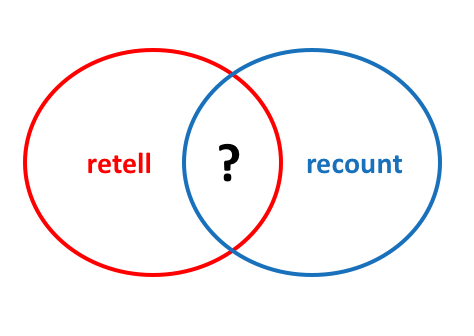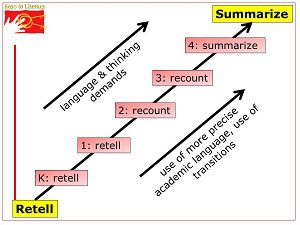Retell, Recount, Summary: What’s the difference?

Most educators agree that having students of all ages describe text they have read is a helpful comprehension strategy. This includes retelling or recounting, summarizing, and paraphrasing. In reading standard #2, the Common Core Standards require students in grades K-1 to “retell”, students in grades 2-3 to “recount”, and students in grades 4-12 to “summarize”. However, many students and their teachers are not sure about what each term means.
Retell for K-3 and summary for 4-12 are major components of our Key Comprehension Routine and Keys to Literacy trainers are often asked to explain the difference between the two. The main difference is that a retell includes everything (main ideas and details) while a summary is more condensed and focused on main ideas. Students paraphrase when they restate information in their own words, which they do when they retell or summarize.
After the Standards were adopted by most states and added the term recount, we were curious to understand how the Standards interpreted the difference between retell and recount, and it is something teachers continue to ask us when we are providing professional development. We first addressed this topic in an October, 2014 blog post titled “Recount: Is It Relevant?” in which we concluded that recount was a more sophisticated extension of retell that places more language and thinking demands on students, and a step towards preparing students in grades 2 and 3 to make the leap to summarizing by grade 4. The visual below is from a slide we use in our training to illustrate how students must use increasing complex critical thinking skills and more precise academic language (including transition words and phrases) as they move from Kindergarten to Grade 4.

After reading a blog post by Dea Conrad-Curry titled “Retell, Recount, Summarize? A Common Core Shift from Kindergarten to Fourth Grade”, I decided to address this topic again.
Conrad-Curry notes the following about the Common Core use of the terms retell and recount:
“For some, this seemingly simple verb change indicates no instructional change; but for one who approaches text like a puzzle to be solved, this seemingly simple change is a Columbo clue… the change in wording from “retell” to “recount” has done more than spark curiosity within my brain.”
In her blog, she provides details from her search of literacy sources that began with the goal of finding a clear definition of the distinction between the two words. Alas, Conrad-Curry reports that the results of the probe were inconclusive, resulting her need to make her best professional judgement to interpret what reading standard #2 intends. You can link to her blog to read details from the various sources that she consulted, but here’s what she concluded:
“Retell implies an oral recapitulation of the narrative elements, probably best put in order but not necessarily; as we speak, we may correct our thoughts and provide for that correction in our speaking. On the other hand, recount may be written or oral and requires a clearly sequenced ordering of narrative events. Retelling is less formal and probably told from the point-of-view of the story’s original narrator and in the tense the story was told; recounting, more formal in stance, sets the context for the recount from the beginning and is told in either first person or third person depending on the nature of the recount, but always told in past tense.”
What do you think? Why did the architects of the Common Core make a distinction between retell and recount?
Here are two free related Keys to Literacy video resources:

 Joan Sedita is the founder of Keys to Literacy and author of the Keys to Literacy professional development programs. She is an experienced educator, nationally recognized speaker and teacher trainer. She has worked for over 35 years in the literacy education field and has presented to thousands of teachers and related professionals at schools, colleges, clinics, and professional conferences.
Joan Sedita is the founder of Keys to Literacy and author of the Keys to Literacy professional development programs. She is an experienced educator, nationally recognized speaker and teacher trainer. She has worked for over 35 years in the literacy education field and has presented to thousands of teachers and related professionals at schools, colleges, clinics, and professional conferences.
I needed to check this out because I ran across a worksheet that states, “A summary is NOT a retelling, although it may have some of the same elements as a retelling A summary leaves out all unimportant characters and a listing of events. A summary may also include some of your own ideas. You may tell what you think the author’s purpose or message is”
I have always told my students, grades 5-8, that a summary should relate the gist of the fictional story most importantly including the progression of character development and conflict resolution. I instruct them to not put in their own predictions or interpretations of the story’s theme.
Any thoughts on my interpretation?
I agree with you rather than some of what you read in that worksheet. A retell and a summary are similar in that the student has to use his language to “give back” what was read. The big difference I see is that a retell (focused more on Bloom’s remembering and understanding levels) does not involve as much critical thinking as does a summary (requires analysis and synthesis). The other big difference is that retell should include a lot of detail, whereas summary should not — it should just focus on the “big ideas”. Getting back to the comments on the worksheet: This is an example of a mistake that teachers often make when it comes to writing assignments — they want something specific, but instead just ask for a summary.Based on the directions on the worksheet, what the teacher really wanted was a short essay about what the student thought was the author’s purpose. Including the student’s ideas would be appropriate for that kind of writing task. I agree with what you tell your students about a summary. A summary of narrative text (i.e., story) must include the key characters, setting, major events, and description of the problem/solution (if there was one). Although if the specific task was “write a plot summary”, then the student would focus just on the main events. Either way, a true summary should not have room for the student to add his own ideas!
Can a recount be given before the story is actually told, like a “forward” in a book, or does it come at the end ?
Good question! We have to keep in mind that for young ones in K-3, it might be taxing to have them do a version of the task twice. In most cases having them give their best try at recounting/retelling is the place to start, but then following up by giving them feedback about how to improve what they’ve shared.
Retell/Recount
With one you tell the story over in your own words and with the other you say what has already been said